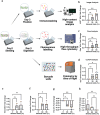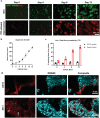An Automation Workflow for High-Throughput Manufacturing and Analysis of Scaffold-Supported 3D Tissue Arrays
- PMID: 37086259
- PMCID: PMC11468893
- DOI: 10.1002/adhm.202202422
An Automation Workflow for High-Throughput Manufacturing and Analysis of Scaffold-Supported 3D Tissue Arrays
Abstract
Patient-derived organoids have emerged as a useful tool to model tumour heterogeneity. Scaling these complex culture models while enabling stratified analysis of different cellular sub-populations, however, remains a challenge. One strategy to enable higher throughput organoid cultures is the scaffold-supported platform for organoid-based tissues (SPOT). SPOT allows the generation of flat, thin, and dimensionally-defined microtissues in both 96- and 384-well plate footprints that are compatible with longitudinal image-based readouts. SPOT is currently manufactured manually, however, limiting scalability. In this study, an automation approach to engineer tumour-mimetic 3D microtissues in SPOT using a liquid handler is optimized and comparable within- and between-sample variation to standard manual manufacturing is shown. Further, a liquid handler-supported cell extraction protocol to support single-cell-based end-point analysis using high-throughput flow cytometry and multiplexed cytometry by time of flight is developed. As a proof-of-value demonstration, 3D complex tissues containing different proportions of tumour and stromal cells are generated to probe the reciprocal impact of co-culture. It is also demonstrated that primary patient-derived organoids can be incorporated into the pipeline to capture patient-level tumour heterogeneity. It is envisioned that this automated 96/384-SPOT workflow will provide opportunities for future applications in high-throughput screening for novel personalized therapeutic targets.
Keywords: 3D in vitro cancer models; automation; tumour microenvironments.
© 2023 The Authors. Advanced Healthcare Materials published by Wiley-VCH GmbH.
Conflict of interest statement
The authors declare no conflict of interest.
Figures







Similar articles
-
An off-the-shelf multi-well scaffold-supported platform for tumour organoid-based tissues.Biomaterials. 2022 Dec;291:121883. doi: 10.1016/j.biomaterials.2022.121883. Epub 2022 Oct 27. Biomaterials. 2022. PMID: 36343611
-
A fully automated high-throughput workflow for 3D-based chemical screening in human midbrain organoids.Elife. 2020 Nov 3;9:e52904. doi: 10.7554/eLife.52904. Elife. 2020. PMID: 33138918 Free PMC article.
-
Fluorescence-based Single-cell Analysis of Whole-mount-stained and Cleared Microtissues and Organoids for High Throughput Screening.Bio Protoc. 2021 Jun 20;11(12):e4050. doi: 10.21769/BioProtoc.4050. eCollection 2021 Jun 20. Bio Protoc. 2021. PMID: 34262994 Free PMC article.
-
High-throughput solutions in tumor organoids: from culture to drug screening.Stem Cells. 2025 Jan 17;43(1):sxae070. doi: 10.1093/stmcls/sxae070. Stem Cells. 2025. PMID: 39460616 Free PMC article. Review.
-
High-throughput single-cell transcriptomics on organoids.Curr Opin Biotechnol. 2019 Feb;55:167-171. doi: 10.1016/j.copbio.2018.11.002. Epub 2018 Nov 29. Curr Opin Biotechnol. 2019. PMID: 30504008 Review.
Cited by
-
Mini-MEndR: a miniaturized 96-well predictive assay to evaluate muscle stem cell-mediated repair.BMC Methods. 2024;1(1):5. doi: 10.1186/s44330-024-00005-4. Epub 2024 Jun 7. BMC Methods. 2024. PMID: 38872952 Free PMC article.
-
Exploring New Dimensions of Tumor Heterogeneity: The Application of Single Cell Analysis to Organoid-Based 3D In Vitro Models.Adv Healthc Mater. 2023 Oct;12(26):e2300903. doi: 10.1002/adhm.202300903. Epub 2023 Aug 27. Adv Healthc Mater. 2023. PMID: 37589373 Free PMC article. Review.
References
-
- Costard L. S., Hosn R. R., Ramanayake H., O'Brien F. J., Curtin C. M., Acta Biomater. 2021, 132, 360. - PubMed
-
- Brancato V., Oliveira J. M., Correlo V. M., Reis R. L., Kundu S. C., Biomaterials 2020, 232, 119744. - PubMed
-
- Broutier L., Mastrogiovanni G., Verstegen M. M., Francies H. E., Gavarró L. M., Bradshaw C. R., Allen G. E., Arnes‐Benito R., Sidorova O., Gaspersz M. P., Georgakopoulos N., Koo B.‐K., Dietmann S., Davies S. E., Praseedom R. K., Lieshout R., IJzermans J. N. M., Wigmore S. J., Saeb‐Parsy K., Garnett M. J., van der Laan L. J., Huch M., Nat. Med. 2017, 23, 1424. - PMC - PubMed
-
- Vlachogiannis G., Hedayat S., Vatsiou A., Jamin Y., Fernández‐Mateos J., Khan K., Lampis A., Eason K., Huntingford I., Burke R., Rata M., Koh D.‐M., Tunariu N., Collins D., Hulkki‐Wilson S., Ragulan C., Spiteri I., Moorcraft S. Y., Chau I., Rao S., Watkins D., Fotiadis N., Bali M., Darvish‐Damavandi M., Lote H., Eltahir Z., Smyth E. C., Begum R., Clarke P. A., Hahne J. C., et al., Science 2018, 359, 920. - PMC - PubMed
Publication types
MeSH terms
LinkOut - more resources
Full Text Sources
Medical
Research Materials

